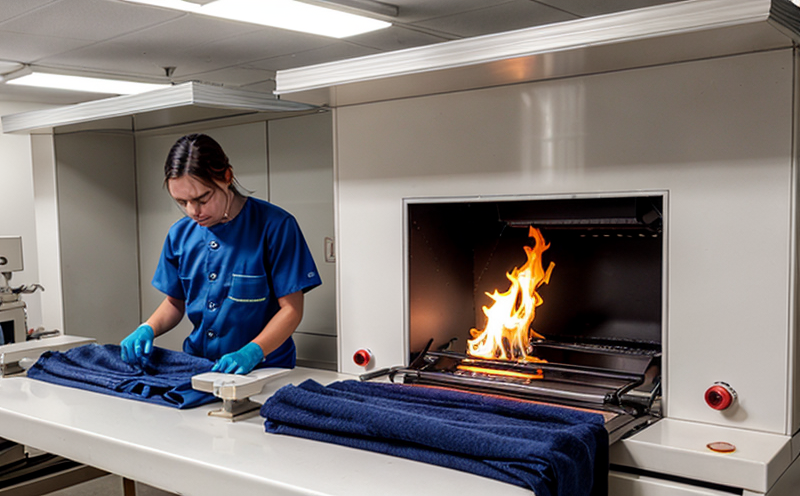Flammability Testing of Protective Outerwear
The flammability testing of protective outerwear is a critical process aimed at ensuring that garments meet stringent safety standards. This service ensures that the materials and design features used in protective clothing can withstand potential ignition sources, thereby safeguarding workers from burns and other injuries. Flammability tests are particularly important for industries where employees may be exposed to fire hazards, such as firefighting, chemical plants, and oil refineries.
Protective outerwear is designed with multiple layers of materials that provide insulation against heat, chemicals, and physical impacts. The flammability testing process focuses on evaluating how these materials behave under controlled combustion conditions. This includes assessing the ignition time, flame spread rate, and the ability to extinguish flames once removed from an igniting source.
One common test method for assessing the flammability of protective outerwear is the ISO 13565-2 standard, which specifies procedures for measuring the flame spread and heat release rates of textiles. Another relevant standard is ASTM D6413, which provides guidelines for testing the flame resistance of fabrics used in protective clothing.
The testing process typically involves cutting specimens from the outerwear according to specific dimensions defined by the relevant standard. These specimens are then subjected to controlled combustion conditions, such as those provided by a cone calorimeter or a flame spread tester. The test results provide critical data on the flammability properties of the materials used in protective clothing.
Flammability testing is not only about ensuring that garments meet regulatory requirements but also about improving product design and performance. By understanding how different materials behave under fire conditions, manufacturers can make informed decisions to enhance the safety and effectiveness of their products. This service plays a vital role in maintaining public and worker safety by preventing accidents and injuries caused by clothing ignition.
| Industry | Application |
|---|---|
| Fighting fires | Firefighters use protective outerwear to minimize the risk of burns and other injuries from fire. |
| Hazardous environments | Cleaning staff in chemical plants wear protective outerwear to protect against accidental exposure to hazardous materials. |
| Use Case | Application Example |
|---|---|
| Evaluating the ignition time of protective outerwear. | Testing the ignition time of a firefighter's turnout coat to ensure it meets regulatory standards. |
| Measuring heat release rates during combustion. | Assessing the heat release rate of a hazmat suit in an emergency scenario involving chemical spills. |
- Evaluating flame spread characteristics of protective outerwear.
- Determining the effectiveness of fire-resistant coatings and treatments applied to garments.
- Ensuring compliance with international standards such as ISO, ASTM, and EN for flammability testing.
In conclusion, flammability testing of protective outerwear is an essential service that helps manufacturers produce safe and effective protective clothing. By adhering to industry standards and performing rigorous tests, this service ensures that workers in high-risk environments are protected from the dangers of fire and other ignition sources.
Competitive Advantage and Market Impact
The flammability testing of protective outerwear offers significant competitive advantages to manufacturers. By ensuring that their products meet or exceed regulatory standards, companies can position themselves as leaders in safety and quality. This not only enhances brand reputation but also builds trust with customers who value the highest level of protection.
In today's highly regulated market, compliance with flammability testing is not just a legal requirement; it's a strategic business decision. Companies that consistently meet or exceed these standards can differentiate themselves from competitors and gain a competitive edge in the marketplace. This service helps manufacturers stay ahead of changing regulations and industry trends by providing valuable insights into product performance.
From an operational perspective, flammability testing ensures that protective outerwear performs reliably under extreme conditions. This reduces the risk of accidents, injuries, and fatalities, which can have severe financial implications for both employees and employers. By minimizing these risks, companies can save on costly insurance premiums and avoid potential legal liabilities.
The market impact of this service extends beyond individual businesses to broader societal benefits. By promoting safer working conditions in high-risk environments, flammability testing contributes to overall public health and safety. This aligns with global efforts towards improving occupational safety and reducing workplace injuries and fatalities.
Use Cases and Application Examples
The results of flammability tests are invaluable for various industries that rely on protective outerwear to ensure worker safety. Below are some specific use cases and application examples:
- Fighting fires: Firefighters' turnout coats undergo rigorous testing to ensure they can withstand the intense heat and flames encountered in firefighting operations.
- Hazardous environments: Hazmat suits used by emergency response teams are tested for their flame resistance when dealing with chemical spills or other hazardous materials.
- Risk assessment: Industrial workers, such as those in oil refineries and chemical plants, use protective outerwear that is evaluated for its flammability properties to ensure they can safely perform their duties.
These tests provide critical data on the performance of materials under fire conditions. This information allows manufacturers to refine their products, ensuring they meet or exceed regulatory standards while also enhancing overall safety and effectiveness.
| Industry | Application |
|---|---|
| Fighting fires | Evaluating the ignition time and flame spread characteristics of firefighter turnout coats. |
| Hazardous environments | Assessing the heat release rates of hazmat suits during chemical spills or other emergencies. |
| Use Case | Application Example |
|---|---|
| Evaluating the ignition time of protective outerwear. | Testing the ignition time of a firefighter's turnout coat to ensure it meets regulatory standards. |
| Measuring heat release rates during combustion. | Assessing the heat release rate of a hazmat suit in an emergency scenario involving chemical spills. |





